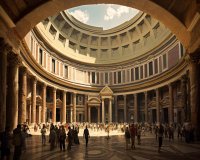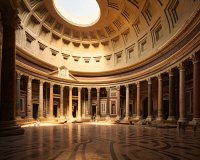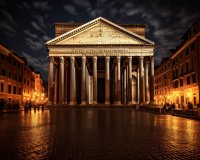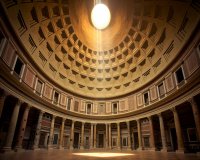Rome’s Piazza Culture: From Piazza Navona to the Pantheon’s Doorsteps
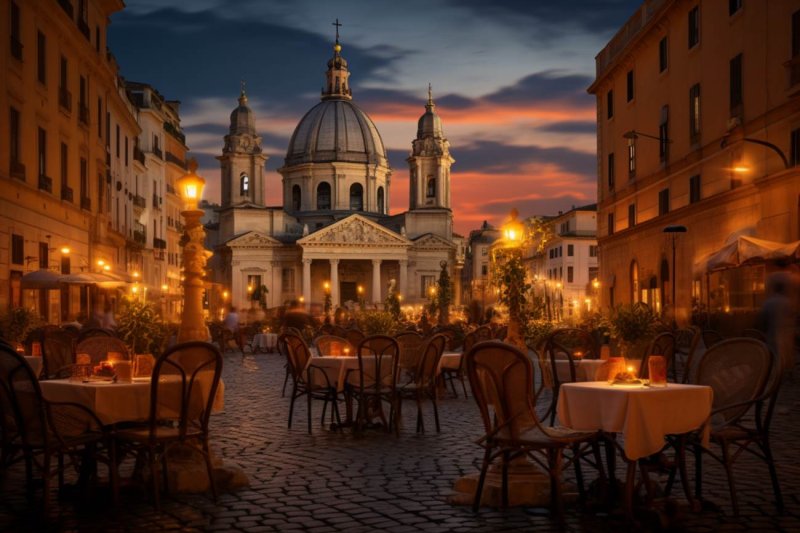
Rome's Piazza Culture: From Piazza Navona to the Pantheon's Doorsteps
Rome, the eternal city, is a place steeped in history and culture. One of the most enchanting aspects of this magnificent city is its piazza culture, where the heart of Rome comes alive in its bustling squares. From the iconic Piazza Navona to the charming doorsteps of the Pantheon, these piazzas hold stories of centuries past and offer a glimpse into contemporary Roman life.
Piazza Navona: The Baroque Beauty
Piazza Navona is a masterpiece of Baroque architecture. Built on the site of the ancient Stadium of Domitian, it is a testament to the passage of time and the evolution of Rome. The centerpiece of this piazza is the stunning Fountain of the Four Rivers designed by Gian Lorenzo Bernini. The piazza is often teeming with street artists, musicians, and tourists, creating a lively atmosphere. It's the perfect spot to enjoy a gelato while taking in the surrounding beauty.
Pantheon's Doorsteps: A Glimpse of Antiquity
Just a stone's throw away from Piazza Navona lies the Pantheon, and its doorsteps are a great place to sit and watch the world go by. The Pantheon itself is a marvel of ancient Roman engineering, and its massive dome remains the world's largest unreinforced concrete dome. The piazza outside is a wonderful place to sip a cappuccino and contemplate the history that surrounds you.
Piazza di Spagna: The Spanish Steps
Piazza di Spagna, home to the iconic Spanish Steps, is another must-visit in Rome. The steps are a meeting point for locals and tourists alike. On the way to the top, you'll find the Keats-Shelley House, a museum dedicated to the English Romantic poets who were inspired by Rome. The piazza also leads to the high-end shopping street, Via Condotti, making it a favorite among fashion enthusiasts.
Piazza del Popolo: The People's Square
Piazza del Popolo, or the People's Square, is a grand, symmetrical square that has a rich history. In the center, you'll find an Egyptian obelisk surrounded by lion statues. This piazza offers a stunning view of the Pincio Hill, a peaceful park overlooking the city. It's an ideal place for a leisurely stroll and to escape the bustling city center.
Piazza Venezia: The Altar of the Fatherland
Piazza Venezia is home to the imposing Altar of the Fatherland, a monument dedicated to the first king of a unified Italy. The piazza is a hub of traffic and the central point of Rome. From here, you can easily reach various famous sites, including the Roman Forum and the Colosseum. Climb to the top of the Altar for a breathtaking panoramic view of Rome.
Piazza della Rotonda: The Pantheon's Neighbors
Piazza della Rotonda, situated right in front of the Pantheon, is a charming square surrounded by cafes and restaurants. It's a delightful place to have a meal and admire the ancient temple's grandeur. The light changes as the day progresses, creating a different atmosphere during the day and night.
Conclusion
Rome's piazza culture is a vital part of the city's identity. These squares are not just places to visit; they are stages where you can witness the eternal city's past and present. Whether you're admiring the Baroque splendor of Piazza Navona, enjoying a coffee near the Pantheon, or taking in the sweeping views from Piazza Venezia, Rome's piazzas will capture your heart and leave you with unforgettable memories.
So, when you find yourself in Rome, don't just visit the famous landmarks; take the time to embrace the city's piazza culture, where the essence of Roman life comes alive amid the timeless beauty of these squares.
Rome Pantheon Guided Tour: Explore Ancient Wonders
Join our guided tour of the Pantheon, an architectural marvel from ancient Rome. With fast-track entrance, delve into the history of this iconic monument as you stroll across its marble floor.
Discover the secrets of the Pantheon's engineering that allowed it to stand as the best-preserved monument from Roman times. Learn how Pope Boniface IV ordered the relocation of martyrs' remains from Christian catacombs to the Pantheon in 608.
Marvel at the immense dome with a 43-meter diameter and the famous oculus, permitting natural light to illuminate the beautiful interior.
Highlights:
- Explore the history of the Pantheon, the best-preserved monument from Ancient Rome.
- Learn about the engineering secrets that make the Pantheon unique.
- Discover the relocation of martyrs' remains on the orders of Pope Boniface IV.
- Admire the immense dome and famous oculus allowing natural light.
Details:
- Duration: 1 hour - 65 minutes
- Live tour guide in English and Italian
- Skip-the-line access through a separate entrance
- Small group for an intimate experience
Meeting Point: Piazza della Rotonda, 4, Rome, in front of "Antica Salumeria" opposite the Pantheon.
Important Information:
- Recommended to bring a sun hat, wear comfortable shoes, and have rain gear.
- All guests must cover shoulders and knees.
- Tour takes place rain or shine.
- Luggage or large bags are not allowed.
Book your spot now and pay later to secure your place today!
Customer Reviews:
Overall rating: 4.6/5 based on 289 reviews
Value for money: 4.4/5
Testimonials:
Claudia was an amazing guide! She presents information in an engaging way, extending beyond the Pantheon.
Jason was extraordinarily knowledgeable about the Pantheon, religious practices, and Rome's history.
Good experience! Despite a change in guide and tour time, our guide was wonderful and knowledgeable.
The Charm of Piazza Navona, Rome
Rome, the eternal city, is a place filled with wonders and history at every corner. Among its many beautiful squares, Piazza Navona stands out as a gem that captivates visitors with its charm and rich history. This historic square, located in the heart of Rome, is a testament to the city's enduring beauty and timeless appeal.
History and Origins
Piazza Navona, known as the Agone by the ancient Romans, was built on the site of the Stadium of Domitian, which dated back to the 1st century AD. The stadium was primarily used for athletic competitions and could accommodate up to 20,000 spectators. Today, the square retains the shape of the original stadium, with three distinct fountains and the Sant'Agnese in Agone church at its center.
The Three Fountains
One of the most remarkable features of Piazza Navona is the trio of stunning fountains that adorn the square. Each fountain has its own unique character and history.
Fontana del Nettuno
The Fontana del Nettuno, also known as the Fountain of Neptune, was designed by Giacomo della Porta in the 16th century. It features a grand statue of Neptune, the Roman god of the sea, surrounded by various mythical sea creatures. This fountain is a true masterpiece of Baroque art.
Fontana del Moro
The Fontana del Moro, or Moor Fountain, was originally designed by Giacomo della Porta but was later modified by Gian Lorenzo Bernini. It showcases a central statue of a Moor wrestling with a dolphin. The fountain is a testament to the artistic genius of Bernini and is a focal point of the square's beauty.
Fontana dei Quattro Fiumi
The Fontana dei Quattro Fiumi, or Fountain of the Four Rivers, is perhaps the most famous of the three fountains in Piazza Navona. Designed by Gian Lorenzo Bernini, it represents the four major rivers of the world known at the time: the Nile, Ganges, Danube, and Rio de la Plata. The fountain is a magnificent display of artistic skill and creativity.
The Sant'Agnese in Agone
At the center of Piazza Navona, you'll find the majestic Sant'Agnese in Agone church. This beautiful baroque church was designed by Francesco Borromini and Girolamo Rainaldi. The church is dedicated to Saint Agnes, who is said to have suffered martyrdom on this very spot. The church's stunning architecture and rich history make it a must-visit when exploring the square.
Entertainment and Street Performers
Piazza Navona is not just about history and architecture; it's a lively place filled with street artists, musicians, and painters who add to the vibrant atmosphere. You can enjoy a leisurely stroll, have a coffee at one of the many outdoor cafes, or simply sit by the fountains and take in the beauty of the square.
Seasonal Events
Throughout the year, Piazza Navona plays host to various events and festivals. During Christmas, the square is transformed into a magical wonderland with a bustling Christmas market, nativity scenes, and holiday lights. In the summer, the square is home to a charming open-air cinema that screens classic Italian films under the stars.
Conclusion
Piazza Navona is a true marvel in the heart of Rome, where history, art, and modern life seamlessly blend together. Its fountains, church, and vibrant atmosphere create a unique experience that enchants visitors from all over the world. When in Rome, make sure to visit this enchanting square and bask in the charm of Piazza Navona.
Rome: Pantheon Official Audio Guide with Fast Track Ticket
Explore Rome's well-preserved Pantheon and its rich history, from a pagan temple to a Christian church, with the official audio guide. Learn about the architectural marvels and the significance of the Basilica of Santa Maria ad Martyres.
Highlights:
- Discover the history of the Pantheon with the official audio guide
- Admire the stunning architecture and the famous oculus
- Contribute to the Basilica of Santa Maria ad Martyres through this tour
Make your way to the Pantheon to collect your audio guide and embark on a journey through its remarkable past. Explore the basilica with 15 listening points and a map, understanding its evolution from a Roman temple to a mausoleum and church.
The Pantheon, constructed in 25-27 B.C., remains one of the few well-preserved ancient Roman buildings. Dedicated to the gods of Pagan Rome, it carries a unique history distinct from other traditional Roman temples.
Includes:
- Pantheon audio guide
- Pantheon skip-the-line entry ticket (if selected)
- Donations to the Basilica of Santa Maria ad Martyres
Important Information:
- Access to the Basilica requires appropriate attire
- Valid ID or credit card necessary for the audio guide deposit
- Service times may vary due to closures, masses, or events
Customer Reviews:
With an overall rating of 4.2/5, visitors have emphasized the ease of bypassing long lines and the awe-inspiring experience of witnessing the Pantheon's grandeur firsthand. Many recommend taking advantage of the audio guide for an immersive understanding of its history.
Reviewed by CClaire from the United States on October 5, 2023:/
"This was great - we did have to walk a bit to pick up the tickets but we BYPASSED about 500 people and walked straight in. You can get the audio guide inside the Pantheon. There is a time on your ticket but just disregard it - it doesn’t matter what time you show up, just the date (we had early morning ticket and didn’t go until 3pm)."
Reviewed by RRaul from the United Kingdom on October 4, 2023:/
"The Pantheon was magnificent, majestic, and a real wonder of the world. Definitely worth buying ahead as the line was so far down the square and we just walked in. The ticket office is at the museum, a little walk away (10min) from the Pantheon so we saw the line, bought the tickets here and then walked back to the museum to pick up and back to the Pantheon."
The Pantheon: Gateway to History
The Pantheon in Rome is an architectural masterpiece and a symbol of the enduring legacy of the Roman Empire. With its iconic dome, impressive portico, and rich history, it stands as a gateway to history, allowing us to peer into the past and marvel at the engineering and artistic achievements of ancient Rome.
Historical Significance
Originally built by Marcus Agrippa in 27 BC and later reconstructed by Emperor Hadrian in 126 AD, the Pantheon has witnessed over two millennia of history. This monumental structure was dedicated to the gods of ancient Rome, and its name, "Pantheon," means "temple of every god." This is a testament to the religious diversity and tolerance of the Roman Empire.
One of the most remarkable aspects of the Pantheon is its well-preserved dome, which was the largest in the world for over a millennium. The dome's design and construction techniques continue to astound architects and engineers to this day. The oculus, a circular opening at the top of the dome, provides natural light and is a marvel of ancient engineering.
Architectural Marvel
The Pantheon's architecture is a marvel that has influenced countless structures throughout history. The portico, supported by massive granite columns, provides a grand entrance to the temple. As you enter the Pantheon, you are immediately struck by the vast, open interior space, which creates a sense of awe and wonder.
The dome, with its perfect proportions and precise construction, is a prime example of ancient Roman engineering expertise. The walls of the Pantheon are made of concrete, another Roman innovation that revolutionized construction and architecture. The coffered ceiling and various decorative elements showcase the skill and artistry of Roman craftsmen.
Cultural Legacy
Over the centuries, the Pantheon has played many roles. It was used as a Christian church in the 7th century, which contributed to its preservation. The tombs of several Italian kings and notable figures, including the artist Raphael, are located within the Pantheon, making it a place of historical and cultural significance.
Today, the Pantheon continues to be a popular tourist destination, drawing visitors from around the world who come to admire its beauty and learn about its history. It has been featured in numerous works of literature, art, and film, further solidifying its place in global culture.
Visiting the Pantheon
If you plan to visit the Pantheon, be sure to take your time exploring both the exterior and interior. The grandeur of the building and the stories it holds within its walls are well worth the visit. Don't forget to look up and admire the oculus, as it creates a breathtaking interplay of light and shadow within the temple.
Remember to respect the historical and cultural significance of the Pantheon, as it is not just a tourist attraction but a living monument to the past. It's a place to connect with the ancient world and gain a deeper appreciation for the enduring legacy of the Roman Empire.
Conclusion
The Pantheon, with its remarkable history, architectural genius, and cultural significance, truly stands as a gateway to history. It offers a glimpse into the world of ancient Rome and the enduring impact of Roman engineering and culture. Visiting the Pantheon is not just a touristic experience; it's a journey through time and a testament to the enduring power of human creativity and innovation.



